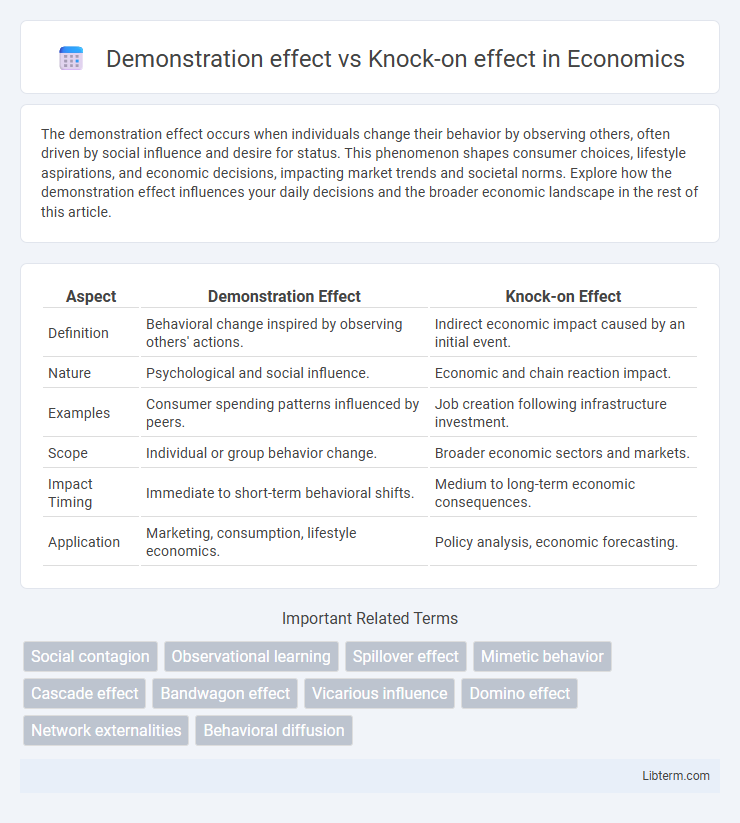The demonstration effect occurs when individuals change their behavior by observing others, often driven by social influence and desire for status. This phenomenon shapes consumer choices, lifestyle aspirations, and economic decisions, impacting market trends and societal norms. Explore how the demonstration effect influences your daily decisions and the broader economic landscape in the rest of this article.
Table of Comparison
| Aspect | Demonstration Effect | Knock-on Effect |
|---|---|---|
| Definition | Behavioral change inspired by observing others' actions. | Indirect economic impact caused by an initial event. |
| Nature | Psychological and social influence. | Economic and chain reaction impact. |
| Examples | Consumer spending patterns influenced by peers. | Job creation following infrastructure investment. |
| Scope | Individual or group behavior change. | Broader economic sectors and markets. |
| Impact Timing | Immediate to short-term behavioral shifts. | Medium to long-term economic consequences. |
| Application | Marketing, consumption, lifestyle economics. | Policy analysis, economic forecasting. |
Introduction to Demonstration Effect and Knock-on Effect
The demonstration effect occurs when individuals adopt behaviors or consumption patterns by observing others, influencing social norms and economic decisions. The knock-on effect refers to the indirect impact of an initial event triggering a chain reaction across related sectors or activities, amplifying the original change. Both concepts illustrate how actions in one area can propagate influence, with the demonstration effect centered on social learning and the knock-on effect on economic or systemic ripple effects.
Defining the Demonstration Effect
The demonstration effect refers to changes in individual behavior or consumption patterns influenced by observing others, often driven by social comparison or aspiration. It typically occurs when people mimic lifestyles or choices seen in peers or media, aiming to achieve perceived social status or success. This effect contrasts with the knock-on effect, which involves a chain reaction of indirect consequences triggered by an initial event, rather than individual imitation.
Understanding the Knock-on Effect
The knock-on effect refers to the indirect consequences caused by an initial action, often triggering a chain reaction across interconnected sectors or systems. It illustrates how a change in one economic or social area can propagate, influencing other areas through linked dependencies and feedback loops. Understanding the knock-on effect is crucial for policymakers and businesses to anticipate ripple impacts and mitigate cascading risks in complex environments.
Key Differences Between Demonstration and Knock-on Effects
The demonstration effect occurs when individuals imitate behaviors or consumption patterns observed in others, driven primarily by social or psychological influences. In contrast, the knock-on effect refers to a chain reaction where one event causes subsequent impacts across different sectors or systems, often economic or environmental. Key differences lie in the demonstration effect's focus on direct behavioral imitation versus the knock-on effect's broader, indirect consequences spreading through interconnected factors.
Mechanisms Behind the Demonstration Effect
The demonstration effect occurs when individuals modify their behavior after observing others' actions, driven by social learning and aspiration mechanisms. This effect is primarily fueled by visible consumption patterns, lifestyle changes, and status emulation within communities. In contrast, the knock-on effect refers to the indirect, cascading economic or social impacts resulting from an initial event or policy change, often involving multiple sectors and stakeholders.
How Knock-on Effects Influence Systems
Knock-on effects influence systems by causing a chain reaction where one event triggers subsequent events across interconnected components, intensifying overall system impact. These cascading consequences often amplify disruption, affecting multiple layers such as supply chains, economic stability, and social structures. Understanding knock-on effects is crucial for designing resilient systems that anticipate and mitigate secondary impacts from primary shocks.
Real-world Examples of the Demonstration Effect
The demonstration effect occurs when individuals or groups imitate behaviors observed in others, often seen in consumer habits like adopting new technology after witnessing peers use smartphones or electric vehicles. For instance, the rapid spread of wearable fitness trackers in urban areas illustrates how visibility encourages adoption, while the knock-on effect refers to a chain reaction of consequences stemming from an initial event, such as job losses in a factory triggering declines in local businesses. Real-world examples of the demonstration effect highlight how social influence drives market trends, shaping consumer choices and accelerating innovation diffusion.
Case Studies Illustrating Knock-on Effects
Case studies in economic development reveal the knock-on effect as a chain reaction where initial investments in infrastructure trigger multiple downstream benefits, such as increased employment, enhanced supply chains, and regional growth. For example, China's Belt and Road Initiative demonstrates how large-scale infrastructure projects catalyze industrial expansion and cross-border trade, generating extensive knock-on effects across participating countries. Empirical evidence from these cases highlights the importance of strategic planning to maximize positive spillovers and mitigate unintended negative consequences.
Implications for Policy and Decision-Making
The demonstration effect influences policy by encouraging governments to adopt successful innovations or reforms observed in other regions, enhancing best practice diffusion and fostering competitive improvement. In contrast, the knock-on effect highlights the cascading consequences of initial policy decisions, necessitating comprehensive impact assessments to mitigate unintended economic or social disruptions. Policymakers must integrate both effects to balance proactive learning with strategic foresight, ensuring resilient and adaptive governance frameworks.
Conclusion: Comparing Demonstration and Knock-on Effects
Demonstration effects primarily influence behavior through observed actions, triggering imitation in social or economic contexts, while knock-on effects represent the broader chain of indirect consequences following an initial event. Both effects reveal the ripple nature of influence but differ in immediacy and scope, with demonstration effects seen in direct behavioral changes and knock-on effects manifested in extended systemic impacts. Understanding these distinctions aids policymakers and analysts in predicting outcomes and designing interventions that consider both immediate mimicry and longer-term cascading results.
Demonstration effect Infographic

 libterm.com
libterm.com